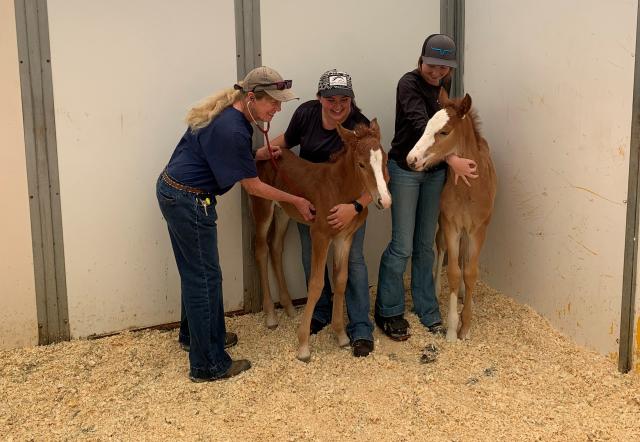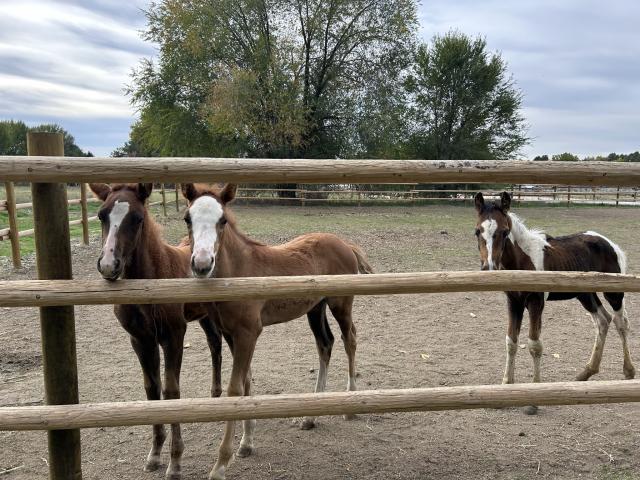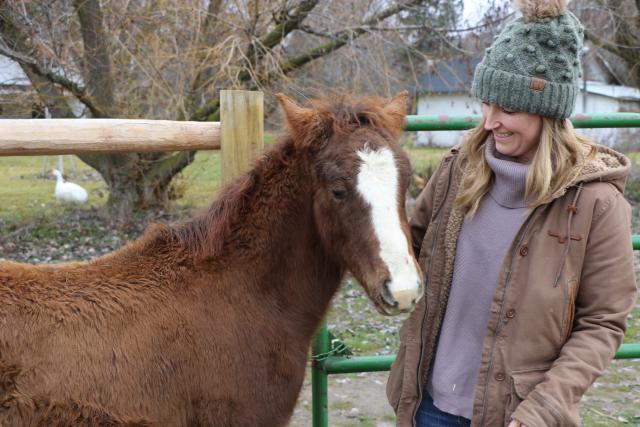You are viewing ARCHIVED content published online before January 20, 2025. Please note that this content is NOT UPDATED, and links may not work. Additionally, any previously issued diversity, equity, inclusion or gender-related guidance on this webpage should be considered rescinded. For current information, visit https://www.blm.gov/blog.
Dr. Annie Roach: A True Triple Wild Horse Heroine
Annie Roach grew up in Reno, Nevada in the shadow of the Sierra Nevada mountains. She loved to watch the wild horses running freely on the range near her childhood home, the very same horses whose forebears inspired the grass roots campaign that achieved federal protection for them and free roaming burros in 1971. Though Dr. Roach was born many years after her death, Velma Johnston, the Reno woman nicknamed “Wild Horse Annie” for galvanizing a nation to push for the protection of these beloved icons, would have been very proud to know her.
Roach grew up with a love of horses and was an avid youth competitor in hunter jumper shows along the west coast. She always planned to be a veterinarian, so after finishing undergraduate studies at the University of California, Davis, Roach moved to Colorado to complete her master’s degree in Assisted Reproductive Technologies. It was while living in Fort Collins that Roach met her future husband, Zach, and they soon relocated to his home state of Minnesota so that Annie could pursue her veterinary degree.
As busy as she was with school and her upcoming marriage, Roach found she missed the simple joy of having her own equine partner. She decided that the perfect complement to her life would be a nice trail horse. Once the decision was made to add an equine family member, the choice seemed obvious, and she began looking into adopting a wild horse like the ones she grew up admiring. “I guess it was inevitable,” she said with a laugh. “I grew up my whole life watching those beautiful horses on the range, and it seemed only fitting that I finally own one.”
A gorgeous black mare available for adoption through the TIP (Trainer Incentive Program) caught her eye. The mare was located in South Dakota, and Annie convinced her new husband (as in BRAND new – they were driving home to Minnesota after their wedding in California!), to make a short segue off the freeway to meet her potential new partner. Roach took one look at the mare she would name Willow and a love affair was born. The rest, as they say, was history.
After bringing five-year-old Willow home to Minnesota, Roach sent her to a nearby trainer to be started under saddle, and soon Willow was the trusted trail horse and partner that Annie had dreamed of.
After her graduation from vet school, Roach and her husband moved to Idaho for her internship at Idaho Equine Hospital in Nampa. While working at Idaho Equine, Annie developed a close friendship with one of her mentors, Dr. Liz Scott, and the two discovered their mutual love of the American wild horse. Dr. Scott is one of the veterinarians charged with overseeing the health of equines housed at the Bureau of Land Management’s Boise Off-Range Wild Horse Corral, and a staunch advocate for the horses and burros protected under the 1971 Wild Free-Roaming Horse and Burro Act.
Roach and her husband fell in love with the Boise area and made the decision to settle in the Treasure Valley after her internship was completed. They eventually added another wild horse to their family with the adoption of a pretty palomino mare, Peach. Peach was a competitor in the 2022 Mustang Mania Under-Saddle Competition with local trainer Emily Hickey. Under Hickey’s guidance, Peach was named the winner of the competition and Annie and Zach knew she’d be the perfect companion to accompany them and Willow as they explored the trails around their new home.
When Willow came down with colic in September 2023, no thought was required about who would provide the mare’s emergency medical care; she was rushed to Idaho Equine Hospital, and when the situation was unable to be resolved medically, Dr. Pete Knox performed life-saving surgery. The surgical intervention was successful, but Willow’s recovery was a long process, fraught with many challenges that required frequent follow-up appointments at the clinic.
It was during one of those appointments that Roach was introduced to two young foals that had been brought to the hospital for additional care following Idaho’s Black Mountain, Hardtrigger and Sands Basin wild horse gather. The chestnut fillies were being looked after by Dr. Scott, and Scott’s veterinary technician Cassidy, a close friend of Annie, who broached the idea of her fostering one of the foals.

“Cassidy approached me and asked if I would be willing to take one of the little ones home to care for her until she was old enough to be weaned and adopted out to a good home. I knew the commitment it would take to care for a foal that young, especially with her needing to be fed every four hours, so I did “ask” (air quotes from Roach herself) my husband if it would be OK. He is used to being married to a vet though, so I don’t think he was super surprised,” she said with a laugh.
Before long the request turned to the fostering of both foals, and as Roach recounted, “The answer was, well, if I’m going to care for one, I might as well have two!” The babies moved to Roach’s home in Eagle where they were good company for the recuperating Willow, who was confined to a small pen as she recovered from her illness and the complications she experienced after surgery.
It was during a subsequent follow-up visit for Willow at Idaho Equine that Roach learned there was a third foal at the clinic that needed help. A young paint colt had been brought in to ensure he received some extra attention. This new foal also needed a foster home until he was old enough to be adopted, and when Dr. Scott mentioned the baby to Roach, she felt it was only right to add him to her nursery. The two chestnut fillies were joined by their new brother, Lemon, about a week after they settled into their Eagle foster home.

Providing the daily around the clock care required by these foals wasn’t possible for Roach to do alone, so she gratefully accepted help from a group of veterinary technician friends who took shifts caring for the youngsters during times when she could not be there. “I was so lucky to be able to count on my group of friends who volunteered to help with the feeding and monitoring of my little charges,” she recounted. “It truly took a village, and I would not have been able to do it without them.”
At first all of the babies seemed to thrive, but within days the paint colt started to show signs of distress. “Lemon didn’t adjust well to the feeding at first,” Roach explained. “He got behind nutritionally, and one manifestation of his health problems was an extreme photosensitivity, or adverse reaction to sunlight. He lost his hair in patches wherever the sunlight hit him, and he also developed kidney problems that required treatment back at the equine hospital. He was a very sick little guy, and we were so fortunate to have a talented team that refused to give up on him,” she said.
Once the foal had recovered enough to leave the hospital for the second time, he rejoined his adopted siblings, but with one big change. “Lemon had to wear a full-body jacket when he came home to keep the sun off the patches where his hair was growing back. He was so cute, all decked out in his own baby horse clothes,” she said with a laugh. Happily, Lemon made a full recovery after his initial setback and has overtaken his sisters in both height and weight since he regained his health.
We visited the Roach’s idyllic Eagle property to meet the babies and hear the incredible story of the loving care that has gone into raising them. The beautiful, obviously healthy trio lives in a large paddock featuring a shelter brimming with straw and fresh hay and plenty of room to run. They share their lovely oasis with two exuberant dogs and a variety of chickens and geese.
It was immediately obvious that the young horses were well-socialized; they approached us for scratches and pats as soon as we entered their pasture. Dr. Roach explained, however, that the foals were raised carefully to ensure they didn’t associate their human caretakers with actual mother figures. Foals often test the environment and their boundaries by playfully biting and kicking their friends and their horse mamas, a behavior that can quickly become dangerous to human caretakers as the babies grow to their mature size and weight of 1,000 pounds or more. “We were careful to feed them from buckets hung on the fence rather than hand-feeding with an actual bottle,” she explained. “As anyone who has raised a foal at home knows, these little guys can get pretty demanding with their dams when they are hungry. I didn’t want to take a chance with anyone’s safety as they grew and became more habituated to their feeding schedules.”
The foals were a true testament to the horsemanship that has shaped their young lives. Annie fitted them each in matching blue halters and we took them out for a stroll around her bucolic property. They were as obedient as any toddler in a new environment can possibly be, with a healthy dose of playfulness and inquisitiveness thrown in just to prove they were still babies.
At the completion of our field trip, we had to ask the obvious question: what’s next for the adorable trio? Annie laughed, “Welllllll, Zach and I haven’t really talked about it yet, but I’d like to keep one of them.” Which one? She ruffled the fuzzy forelock of the bald-faced chestnut filly she named Juniper and calls Junie for short. “Probably this one,” she said with a smile. “I love them all, but this little girl is really special to me.” The blaze-faced filly Aspen and the leggy paint colt Lemon looked on, seemingly unperturbed at not being Roach’s first choice. “We will definitely make sure they go to good homes, and I know they will make really nice horses for someone,” she said. “I can’t wait to watch them go on and do great things.”

Dr. Annie Roach is a compliment to her profession and a true example of dedicated horsemanship and love of the equine species. We feel honored to feature her as a triple hero to the American wild horse.
Make plans to adopt your own wild horse or burro and create your own story!
Submit your own wild horse or burro story to [email protected].
Paula Cook, Guest Writer
Related Content
Related Stories
- Progress on Public Lands: BLM 2025 Trump Administration Accomplishments | January 20 - December 31, 2025
- Popular posts: BLM's most viewed blogs of 2025
- “Where did my horse come from?” BLM launches a new way for adopters, trainers and others to learn about their wild horses and burros
- Lake Havasu Fisheries Improvement Program is the gift that keeps giving
- BLM is thankful for public lands volunteers
